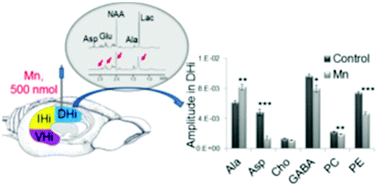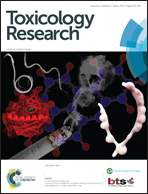Impact of manganese on the hippocampus metabolism in the context of MEMRI: a proton HRMAS MRS study†
Abstract
Manganese enhanced MRI (MEMRI) offers many possibilities such as tract tracing of neuronal pathways and functional imaging in vivo. This technique necessitates a direct or indirect acute injection of MnCl2 in the brain. Unfortunately, local concentrations of Mn2+ and its impact on metabolism after a single injection remain largely unknown. In this study, we combined in vivo MEMRI and ex vivo Proton High Resolution Magic Angle Spinning MRS (1H HRMAS MRS) to investigate the delayed impact of Mn2+ on rat hippocampal metabolism. MEMRI images were acquired 24 h after MnCl2 injection in the dentate gyrus of the rat hippocampus at two different Mn2+ doses: low (8 nmol; n = 16) and high (500 nmol; n = 10). The low Mn2+ dose had almost no impact on hippocampal metabolism while the high dose altered the amplitude of several metabolites (up to +54% for Glu and −71% for Asp). Moreover, at this high dose, the paramagnetic properties of Mn2+ led to a broadening of the resonances of several organic acids (lactate, glutamate, N-acetyl aspartate etc.), suggesting a chelation of Mn2+ and an impact on Mn2+ relaxivity. Metabolite amplitudes were well correlated with the Mn2+ concentrations measured with an MRI T1-map (glutamate: R2 = 0.8, p = 0.02; phosphoethanolamine: R2 = 0.9, p = 0.0004; γ-aminobutyrate: R2 = 0.7, p = 0.005 and phosphocholine: R2 = 0.6, p = 0.04). To conclude, HRMAS is well suited to investigate Mn2+ impact on the metabolism. The low Mn2+ dose (8 nmol) usually used in the MEMRI experiment does not impact the hippocampal metabolism. The chelation of Mn2+ and its impact on relaxivity suggests an over-estimation of the Mn2+ concentration when measured through a T1 map.


 Please wait while we load your content...
Please wait while we load your content...